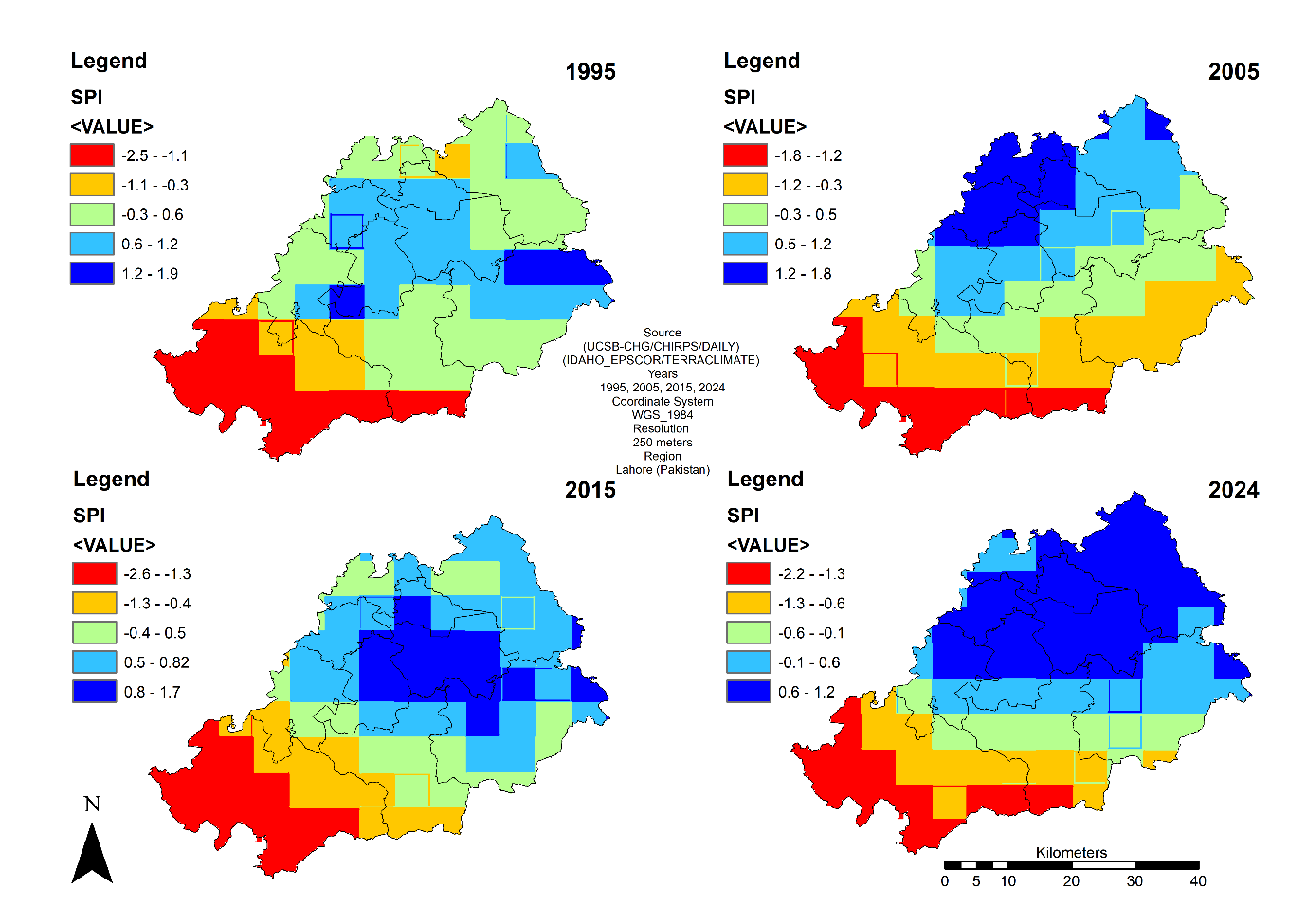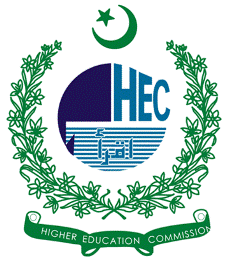Spatio-Temporal Analysis of Meteorological Drought in Lahore (1995–2024)
Keywords:
Urban Resilience, Meteorological Drought, SPI & SPEI, Precipitation VariabilityAbstract
Evaluating urban meteorology is essential for efficient water resource management, especially considering climate change and an increase in Urban population. It helps to understand the severity and scope of drought conditions, which enables improved planning and execution of drought response measures. This research paper examines long-term patterns of rainfall variability and drought situations in Lahore, spanning a period of 30 years (1995- 2024). Monthly rainfall data taken from the UCSB-CHG/CHIRPS dataset, along with potential evapotranspiration (PET) information from the TERRACLIMATE dataset, are being analyzed using the Standardized Precipitation Index (SPI) and Standardized Precipitation Evapotranspiration Index (SPEI). The whole dataset is processed by Google Earth Engine (GEE), with Lahore’s administrative boundaries used to define the Area of Interest (AOI). The analysis recognizes significant annual and spatial variability, with the mean annual Precipitation recorded at 65.35mm. Extreme years included 2021, with 184.77 mm, and 2019, in this year precipitation was only recorded at 13.06 mm, which highlights growing climatic inconsistencies. SPI values dipped as low as -2.6 in 2015 in the southern part of Lahore, indicating severe drought conditions, while northern Lahore experienced values as high as 1.7, denoting extreme wetness. SPEI values exhibited a similar pattern, with the southern region recorded -2.3 in 2024, reflecting ongoing moisture stress, contrasted by northern Lahore reaching 1.2 to 2, a marked improvement in hydrological balance. These results show that Lahore is becoming more and more vulnerable to both drought and flooding because of urban growth and changes in the monsoon. According to the findings, localized, data-driven climate adaptation policies that prioritize drought resistance, water conservation, and efficient urban planning are essential.
References
A. M. & K. E. T. Sourav Mukherjee, “Climate Change and Drought: a Perspective on Drought Indices,” Curr. Clim. Chang. Reports, vol. 4, pp. 145–163, 2018, doi: https://doi.org/10.1007/s40641-018-0098-x.
A. S. David García-León, Gabriele Standardi, “An integrated approach for the estimation of agricultural drought costs,” Land use policy, vol. 100, p. 104923, 2021, doi: https://doi.org/10.1016/j.landusepol.2020.104923.
R. K. Yannis Markonis, “The rise of compound warm-season droughts in Europe,” Sci. Adv., vol. 7, no. 6, p. 2, 2021, doi: 10.1126/sciadv.abb9668.
N. J. D. and J. K. Thomas B. McKee, “THE RELATIONSHIP OF DROUGHT FREQUENCY AND DURATION TO TIME SCALES,” Eighth Conf. Appl. Climatol., 1993, [Online]. Available: https://www.droughtmanagement.info/literature/AMS_Relationship_Drought_Frequency_Duration_Time_Scales_1993.pdf
Iqbal, N., et al., Linkages between typologies of existing urban development patterns and human vulnerability to heat stress in Lahore. Sustainability, 2022. 14(17): p. 10561.
Zhang, X., et al., Urban drought challenge to 2030 sustainable development goals. Science of the Total Environment, 2019. 693: p. 133536.
M. A. Muhammad Shahzaman, Weijun Zhu, Muhammad Bilal, Birhanu Asmerom Habtemicheal, Farhan Mustafa, “Remote Sensing Indices for Spatial Monitoring of Agricultural Drought in South Asian Countries,” Remote Sens, vol. 13, no. 11, p. 2059, 2021, doi: https://doi.org/10.3390/rs13112059.
M. Alimullah Miyan, “Droughts in Asian Least Developed Countries: Vulnerability and sustainability,” Weather Clim. Extrem., vol. 7, pp. 8–23, 2015, doi: https://doi.org/10.1016/j.wace.2014.06.003.
T. J. Buda Su, Jinlong Huang, Thomas Fischer, “Drought losses in China might double between the 1.5 °C and 2.0 °C warming,” Proc. Natl. Acad. Sci. U. S. A., vol. 115, no. 42, pp. 10600–10605, 2018, doi: https://doi.org/10.1073/pnas.1802129115.
M. R. M. & M. M. M. Abdol Rassoul Zarei, “Determining the most appropriate drought index using the random forest algorithm with an emphasis on agricultural drought,” Nat. Hazards, vol. 115, no. 1, p. 1, 2023, doi: https://doi.org/10.1007/s11069-022-05579-2.
M. Henchiri, S. Ali, B. Essifi, W. Kalisa, S. Zhang, and Y. Bai, “Monitoring land cover change detection with NOAA-AVHRR and MODIS remotely sensed data in the North and West of Africa from 1982 to 2015,” Environ. Sci. Pollut. Res., vol. 27, no. 6, pp. 5873–5889, Feb. 2020, doi: 10.1007/S11356-019-07216-1/METRICS.
V. Iyakaremye, G. Zeng, I. Ullah, A. Gahigi, R. Mumo, and B. Ayugi, “Recent Observed Changes in Extreme High‐Temperature Events and Associated Meteorological Conditions over Africa,” Int. J. Climatol., vol. 42, no. 9, pp. 4522–4537, Jul. 2022, doi: 10.1002/JOC.7485’)).
Q. M. & S. Z. Guizeng Qi, Hongying Bai, Ting Zhao, “Sensitivity and areal differentiation of vegetation responses to hydrothermal dynamics on the northern and southern slopes of the Qinling Mountains in Shaanxi province,” J. Geogr. Sci., vol. 31, pp. 785–801, 2021, doi: https://doi.org/10.1007/s11442-021-1871-7.
A. R. M. T. I. & A. R. Bushra Praveen, Swapan Talukdar, Shahfahad, Susanta Mahato, Jayanta Mondal, Pritee Sharma, “Analyzing trend and forecasting of rainfall changes in India using non-parametrical and machine learning approaches,” Sci. Rep., vol. 10, no. 10342, 2020, doi: https://doi.org/10.1038/s41598-020-67228-7.
Z. Ha and V. P. Singh, “Entropy-Based Method for Bivariate Drought Analysis,” J. Hydrol. Eng., vol. 18, no. 7, pp. 780–786, Mar. 2012, doi: 10.1061/(ASCE)HE.1943-5584.0000621.
A. Asoka, T. Gleeson, Y. Wada, and V. Mishra, “Relative contribution of monsoon precipitation and pumping to changes in groundwater storage in India,” Nat. Geosci. 2017 102, vol. 10, no. 2, pp. 109–117, Jan. 2017, doi: 10.1038/ngeo2869.
B. Lloyd-Hughes and M. A. Saunders, “A drought climatology for Europe,” Int. J. Climatol., vol. 22, no. 13, pp. 1571–1592, Nov. 2002, doi: 10.1002/JOC.846.
T. B. Edwards, Daniel C., McKee, “Characteristics of 20th century drought in the United States at multiple time scales,” Mt. Sch., 1997, [Online]. Available: https://mountainscholar.org/items/842b69e8-a465-4aeb-b7ec-021703baa6af
A. K. Mishra and V. P. Singh, “A review of drought concepts,” J. Hydrol., vol. 391, no. 1–2, pp. 202–216, 2010, [Online]. Available: https://www.sciencedirect.com/science/article/abs/pii/S0022169410004257
ZargarAmin, SadiqRehan, NaserBahman, and K. I., “A review of drought indices,” Environ. Rev., 2011, doi: https://doi.org/10.1139/a11-013.
C. Wang, B., Ding, Q., Sun, J., & Jin, “South Asian summer monsoon droughts in a warming climate,” Nat. Clim. Chang., vol. 11, no. 3, pp. 222–229, 2021.
W. Li, Y., Zhang, X., & Guo, “Drought monitoring and analysis based on the Standardized Precipitation Index (SPI) in China,” Theor. Appl. Climatol., vol. 139, no. 1–2, pp. 315–332, 2020.
J. R. Thornthwaite, C. W., & Mather, “The water balance,” Publ. Climatol., vol. 8, no. 1, pp. 1–104, 1995.
J. I. L.-M. Vicente-Serrano, Sergio M. Beguería, Santiago, “A Multiscalar Drought Index Sensitive to Global Warming: The Standardized Precipitation Evapotranspiration Index,” J. Clim., vol. 23, no. 7, p. 4, 2010, [Online]. Available: https://journals.ametsoc.org/view/journals/clim/23/7/2009jcli2909.1.xml
D. Tigkas, H. Vangelis, and G. Tsakiris, “Drought characterisation based on an agriculture-oriented standardised precipitation index,” Theor. Appl. Climatol., vol. 135, no. 3–4, pp. 1435–1447, Feb. 2019, doi: 10.1007/S00704-018-2451-3/METRICS.
Mishra, S.S., et al., Meteorological drought assessment in Mumbai city using standardized precipitation index (SPI). International Journal of Environmental Sciences, 2016. 6(6): p. 1036-1046.
Qutbudin, I., et al., Seasonal drought pattern changes due to climate variability: Case study in Afghanistan. Water, 2019. 11(5): p. 1096.

Downloads
Published
How to Cite
License
Copyright (c) 2025 50SEA

This work is licensed under a Creative Commons Attribution 4.0 International License.




















